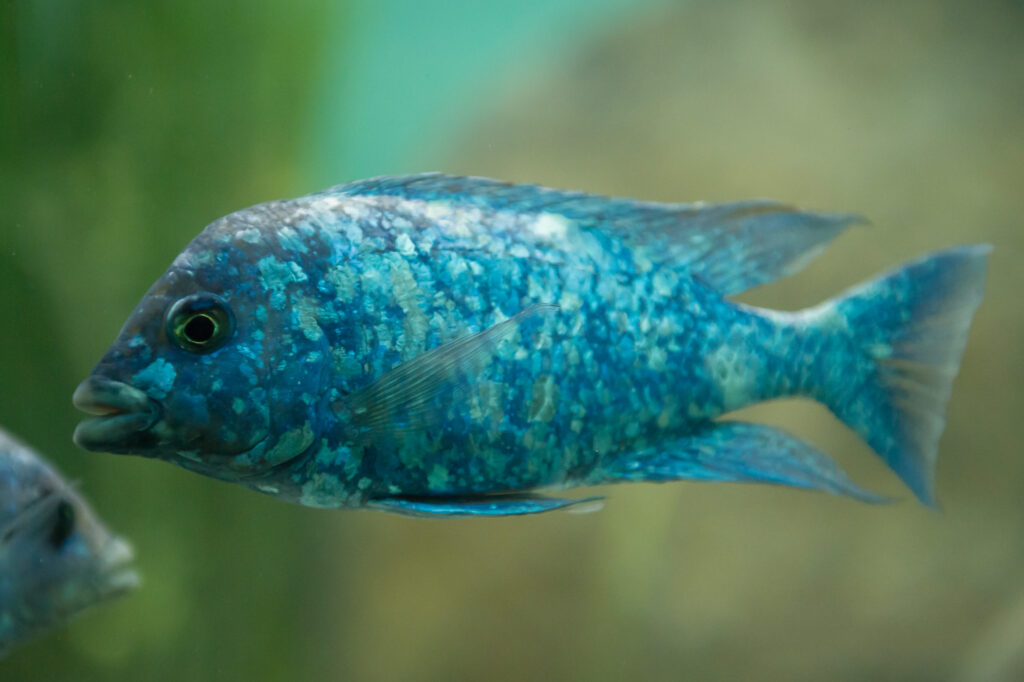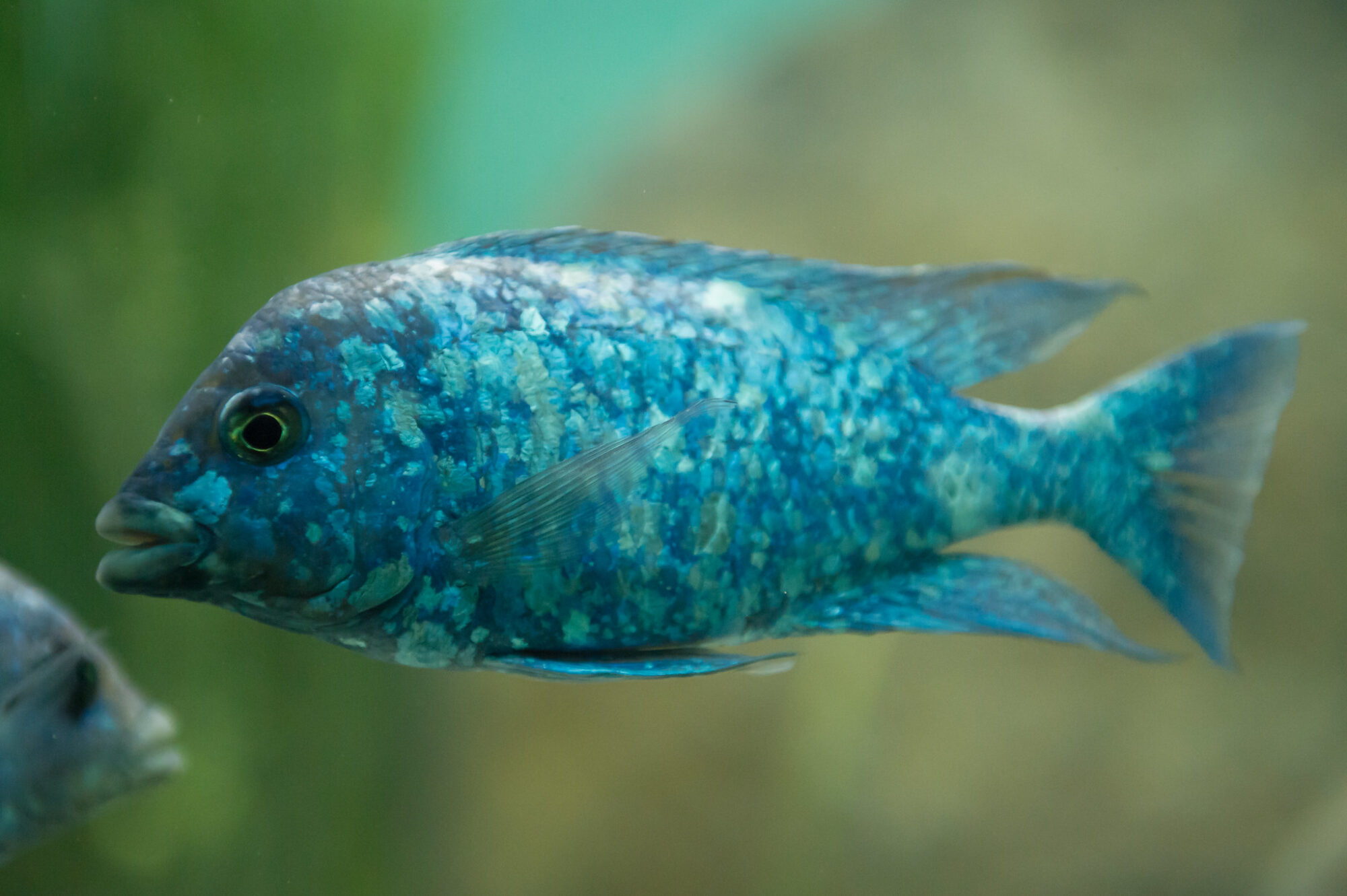The Star Sapphire Cichlid, scientifically known as Placidochromis phenochilus, is a beautiful fish that’s part of the Cichlidae family. This mid-dweller is native to Lake Malawi and is known for its striking blue color with white star-like spots. Related to other African Rift Lake cichlids, it’s a favorite among aquarium enthusiasts.
Table of Contents
Moderately rare in the wild, the Star Sapphire Cichlid is more commonly found in the aquarium trade. Its unique appearance and moderate temperament make it a sought-after addition to many home aquariums. Males are particularly vibrant, especially during breeding, adding to their appeal.
The Star Sapphire Cichlid thrives in sandy areas and is an omnivorous species. It prefers a diet of small invertebrates and algae, and its behavior is generally peaceful. However, it can become territorial, particularly during breeding. Care must be taken to provide the right environment, including a pH of 7.8-8.6 and a temperature of 75-80°F.
With a typical size of 6-8 inches and a lifespan of around 8-10 years in captivity, the Star Sapphire Cichlid is a manageable and rewarding pet. Its history dates back to the 1960s when it was first described scientifically, and its popularity has grown ever since.
Some fun facts about this fish include the pronounced star-like spots that become more visible as the fish matures and its ability to “play dead” to escape predators. These characteristics, along with its striking appearance and moderate temperament, make the Star Sapphire Cichlid a unique and delightful addition to any aquarium.

Key Information
The Star Sapphire Cichlid is a fascinating species with a unique appearance that has made it a favorite among aquarium enthusiasts. While there are no specific variants of this fish, individual coloration can vary slightly, particularly among males. Understanding the various aspects of this fish, from its family to its ideal tank mates, is essential for providing proper care and creating a thriving environment.
| Family | Cichlidae |
| Price | Typically $20-$40 depending on size and coloration |
| Common Names | Star Sapphire Cichlid |
| Variants | No specific variants, coloration may vary |
| Ideal Tank Size | 55-75 gallons |
| Water Parameters | pH 7.8-8.6, temperature 75-80°F |
| Lifespan | 8-10 years in captivity |
| Full Size | 6-8 inches in length |
| Natural Environment | Lake Malawi, Africa |
| Behavior | Generally peaceful, can be territorial |
| Habitat Preference | Sandy areas, mid-dweller |
| Aquarium Decoration | Rocks, caves, and sand substrate |
| Ideal Tank Mates | Other non-aggressive cichlids, catfish |
| Fish to Avoid | Aggressive species, small fish that can be preyed on |
| Best Foods/Diet | Small invertebrates, algae, commercial cichlid food |
| Disease | Susceptible to common fish diseases like Ich |
| Sex-Switch | No known sex-switching behavior |
| Gender Differences | Males are more colorful and larger |
| Care Level | Moderate |
| Breeding Level | Moderate, may breed in captivity with proper care |
Ideal Tank Mates
The Star Sapphire Cichlid is a stunning fish that can be a centerpiece in many aquariums. When it comes to choosing tank mates for this beautiful species, it’s essential to select fish that are compatible in terms of temperament, size, and environmental needs. The Star Sapphire Cichlid is generally peaceful but can be territorial, especially during breeding. Therefore, ideal tank mates should be non-aggressive and able to coexist peacefully with this cichlid.
Here’s a detailed look at 15 ideal tank mates for the Star Sapphire Cichlid:
1. Yellow Lab Cichlid (Labidochromis caeruleus)
A popular choice for many cichlid tanks, the Yellow Lab is known for its bright yellow coloration and peaceful nature. They can coexist well with the Star Sapphire Cichlid, as they share similar water parameters and habitat preferences.
2. Acei Cichlid (Pseudotropheus acei)
Another African cichlid, the Acei, is known for its striking blue color and peaceful temperament. They are compatible with the Star Sapphire Cichlid and can add a splash of color to the tank.
3. Bristlenose Pleco (Ancistrus spp.)
A great algae eater, the Bristlenose Pleco is a non-aggressive species that can share the tank with the Star Sapphire Cichlid. They will help keep the tank clean and add interest to the bottom levels of the aquarium.
4. Red Zebra Cichlid (Metriaclima estherae)
The Red Zebra Cichlid is another colorful addition that can live harmoniously with the Star Sapphire Cichlid. They are generally peaceful and can add a vibrant red hue to the aquarium.
5. Clown Loach (Chromobotia macracanthus)
Known for their playful behavior and striking appearance, Clown Loaches can be a fun addition to a Star Sapphire Cichlid tank. They are non-aggressive and enjoy similar water conditions.
6. Electric Blue Hap (Sciaenochromis fryeri)
This stunning blue cichlid is a perfect match for the Star Sapphire Cichlid in terms of temperament and environmental needs. They can coexist peacefully and add to the visual appeal of the tank.
7. Synodontis Catfish (Synodontis spp.)
A bottom-dweller that enjoys similar water parameters, the Synodontis Catfish can be a great tank mate for the Star Sapphire Cichlid. They are non-aggressive and add diversity to the tank.
8. Peacock Cichlid (Aulonocara spp.)
Peacock Cichlids are known for their beautiful colors and peaceful nature. They can be an excellent match for the Star Sapphire Cichlid, sharing similar habitat preferences and diet.
9. Rainbow Shark (Epalzeorhynchos frenatum)
Though not a real shark, the Rainbow Shark can add a unique look to the tank. They are generally peaceful and can coexist well with the Star Sapphire Cichlid.
10. Zebra Danio (Danio rerio)
A small and active fish, the Zebra Danio can add movement and energy to the tank. They are non-aggressive and can live peacefully with the Star Sapphire Cichlid.
11. Cherry Barb (Puntius titteya)
Cherry Barbs are peaceful schooling fish that can add a splash of red to the aquarium. They are compatible with the Star Sapphire Cichlid and enjoy similar water conditions.
12. Kribensis Cichlid (Pelvicachromis pulcher)
Known for their beautiful coloration and peaceful nature, Kribensis Cichlids can be a great addition to a Star Sapphire Cichlid tank. They share similar environmental needs and can coexist harmoniously.
13. Blue Dolphin Cichlid (Cyrtocara moorii)
The Blue Dolphin Cichlid is another African cichlid that can be a perfect tank mate for the Star Sapphire Cichlid. They are peaceful and share similar water parameters and habitat preferences.
14. Gourami (Trichopodus spp.)
Gouramis are generally peaceful and can add a unique look to the tank. They are compatible with the Star Sapphire Cichlid and enjoy similar water conditions.
15. African Red-Eyed Tetra (Arnoldichthys spilopterus)
A schooling fish that enjoys similar water parameters, the African Red-Eyed Tetra can be a colorful and active addition to a Star Sapphire Cichlid tank.
Choosing the right tank mates for the Star Sapphire Cichlid is essential for creating a harmonious and visually appealing aquarium.
FAQs
How Do Star Sapphire Cichlids Communicate with Each Other?
Star Sapphire Cichlids, like many fish, communicate primarily through body language and color changes. Males may display more vibrant colors to attract females or show dominance, while certain postures and movements can signal different emotions or intentions.
Can Star Sapphire Cichlids Be Kept in a Community Tank with Non-Cichlid Species?
Yes, Star Sapphire Cichlids can be kept in a community tank with non-aggressive non-cichlid species that share similar water parameters and environmental needs. Careful selection of tank mates is essential to ensure compatibility.
What Are the Signs of a Healthy Star Sapphire Cichlid?
A healthy Star Sapphire Cichlid will have clear eyes, vibrant coloration, an active swimming pattern, and a good appetite. Any changes in these behaviors or appearance may signal a health issue that needs attention.
How Can I Enhance the Coloration of My Star Sapphire Cichlid?
Providing a well-balanced diet that includes high-quality cichlid pellets, along with natural foods like brine shrimp and bloodworms, can enhance the coloration of Star Sapphire Cichlids. Proper lighting and water conditions also play a role in maintaining their vibrant colors.
Are Star Sapphire Cichlids Suitable for Beginners?
While not overly demanding, Star Sapphire Cichlids do require some specific care and attention to their environment. They may not be the best choice for complete beginners but can be a rewarding option for those with some experience in fishkeeping.
What Type of Filtration Is Best for Star Sapphire Cichlids?
A good quality filtration system that provides both mechanical and biological filtration is ideal for Star Sapphire Cichlids. Ensuring proper water circulation and regular maintenance will help keep the water clean and healthy for these fish.
Can Star Sapphire Cichlids Be Kept with Plants?
Star Sapphire Cichlids can be kept with live plants, but they may dig and disturb delicate species. Choosing hardy plants that can withstand their behavior, or opting for artificial plants, can create a visually appealing environment without the risk of damage.
How Do Star Sapphire Cichlids React to Changes in Their Environment?
Star Sapphire Cichlids can be sensitive to sudden changes in their environment, such as drastic shifts in water temperature or pH. Gradual acclimation and regular monitoring of water parameters are essential to keep them comfortable and healthy.
What Are the Breeding Habits of the Star Sapphire Cichlid?
Star Sapphire Cichlids are mouthbrooders, meaning the female carries the fertilized eggs in her mouth until they hatch. Providing a suitable breeding environment with hiding spots and maintaining water quality can encourage successful breeding.
Can Star Sapphire Cichlids Be Kept with Invertebrates?
While Star Sapphire Cichlids are primarily fish eaters, they may show interest in small invertebrates like shrimp. It’s best to choose tank mates carefully and monitor their interactions to ensure compatibility.
How Do I Know If My Star Sapphire Cichlid Is Stressed?
Signs of stress in a Star Sapphire Cichlid may include loss of color, erratic swimming, hiding, or refusal to eat. Identifying and addressing the underlying cause, such as water quality issues or incompatible tank mates, is crucial to alleviate stress.
Is It Normal for Star Sapphire Cichlids to Dig?
Yes, Star Sapphire Cichlids are known to dig in the substrate, especially during breeding. Providing a sandy substrate and being mindful of plant placement can accommodate this natural behavior.
What Is the Growth Rate of Star Sapphire Cichlids?
Star Sapphire Cichlids typically grow at a moderate rate, reaching their full size of 6-8 inches within a couple of years. Proper diet and water conditions are essential for healthy growth.
How Should I Introduce Star Sapphire Cichlids to a New Tank?
When introducing Star Sapphire Cichlids to a new tank, it’s essential to acclimate them gradually. Floating the bag in the tank to equalize temperatures and slowly mixing tank water into the bag over an hour can help ease the transition.
Can Star Sapphire Cichlids Recognize Their Owners?
While fish don’t recognize owners in the way mammals might, Star Sapphire Cichlids can become accustomed to the presence of their caregivers. They may associate you with feeding and respond positively to your approach.

Leave a Reply